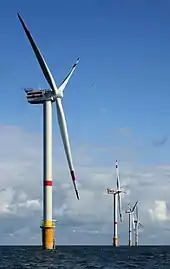Sustainable energy
Sustainable energy is energy produced and used in such a way that it "meets the needs of the present without compromising the ability of future generations to meet their own needs."[2] It is similar to the concepts of green energy and clean energy in its consideration of environmental impacts, however formal definitions of sustainable energy also include economic and social impacts.
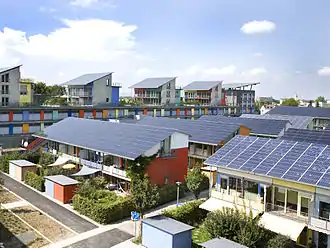

The energy transition to meet the world's needs for electricity, heating, cooling, and power for transport in a sustainable way is widely considered to be one of the greatest challenges facing humanity in the 21st century. Production and consumption of energy emits over 70% of the human-caused greenhouse gas emissions that cause climate change. Worldwide, nearly a billion people lack access to electricity, and around 3 billion rely on smoky fuels such as wood, charcoal or animal dung to cook. These and fossil fuels are a major contributor to air pollution, which causes an estimated 7 million deaths per year.
In general, renewable energy sources such as solar, wind, and hydroelectric energy are widely considered to be sustainable. However, aspects of some renewable energy projects, such as the clearing of forests for the production of biofuels, can lead to similar worse environmental damage than using fossil fuel energy. Nuclear power is a low-carbon source and has a safety record comparable to wind and solar,[3] but radioactive waste and the risk of major accidents are disadvantages of this technology.
Moderate amounts of wind and solar energy, which are intermittent energy sources, can be integrated into the electrical grid without additional infrastructure such as grid energy storage and demand-response measures. These sources generated 8.5% of worldwide electricity in 2019, a share that has grown rapidly.[4] Costs of wind, solar, and batteries are projected to continue falling due to innovation and economies of scale from increased investment.
Proposed pathways for limiting global warming to 1.5 °C describe rapid implementation of low-emission methods of producing electricity and heat, and a shift towards more use of electricity in sectors such as transport. The pathways also include measures to reduce energy consumption; and use of low-carbon fuels, such as hydrogen produced by renewable electricity or with carbon capture and storage. Achieving these goals will require government policies including carbon pricing, energy-specific policies, and phase-out of fossil fuel subsidies.
Definitions
The concept of sustainable development, for which energy is a key component, was described by the United Nations Brundtland Commission in its 1987 report Our Common Future.[5] It defined sustainable development as development that "meets the needs of the present without compromising the ability of future generations to meet their own needs."[5] This description of sustainable development has since been referenced in many definitions of sustainable energy.[5][6][7][2]
No single interpretation of how the concept of sustainability applies to energy has gained worldwide acceptance.[8] The UN Economic Commission for Europe, and various scholars in the field, include several aspects of sustainability in their working definitions of sustainable energy:
- Environmental aspects include greenhouse gas emissions, impacts on biodiversity and ecosystems, the production of hazardous waste and toxic emissions,[8] water consumption,[2] and depletion of non-renewable resources.[7]
- Economic and social aspects include having reliable energy be affordable for all people,[8][7] and energy security so that each country has constant access to sufficient energy.[8][2]
Energy access


Providing sustainable energy is widely viewed as one of the greatest challenges facing humanity in the 21st century, both in terms of meeting the needs of the present and in terms of effects on future generations.[9][10]
As of 2016, 940 million (13% of the world) people do not have access to electricity; two-thirds of whom live in sub-Saharan Africa.[11] The lack of electricity exacerbates the coronavirus pandemic, with half of health facilities having no or poor access to electricity in six surveyed countries in Asia and Africa.[12]
In developing countries, over 2.5 billion people rely on traditional cookstoves[13] and open fires to burn biomass or coal for heating and cooking. This practice causes harmful indoor air pollution, resulting in an estimated 3.8 million deaths annually, particularly among young children and women who spend much time near the hearth.[14] As of 2017, improved access to clean cooking fuels consistently lag improvements in getting more access to electricity.[15] Additionally, serious local environmental damage, including desertification, can be caused by excessive harvesting of wood and other combustible material.[16]
The United Nations Sustainable Development Goal 7 calls for "access to affordable, reliable, sustainable and modern energy for all" by 2030.[17] According to a 2019 report by the IEA, in sub-Saharan Africa "current and planned efforts to provide access to modern energy services barely outpace population growth" and would still leave over half a billion people without electricity and over a billion without clean cooking by 2030.[18]
Pathways for climate change mitigation
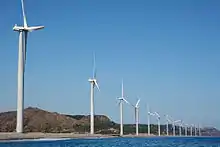

Energy production and consumption are major contributors to climate change, being responsible for 72% of annual human-caused greenhouse gas emissions as of 2014. Generation of electricity and heat contributes 31% of human-caused greenhouse gas emissions, use of energy in transportation contributes 15%, and use of energy in manufacturing and construction contributes 12%. An additional 5% is released through processes associated with fossil fuel production, and 8% through various other forms of fuel combustion.[19][20] As of 2015, 80% of the world's primary energy is produced from fossil fuels.[21]
Cost–benefit analysis work has been done by a disparate array of specialists and agencies to determine the best path to decarbonizing the energy supply of the world.[22][23] The IPCC's 2018 Special Report on Global Warming of 1.5 °C says that for limiting warming to 1.5 °C and avoiding the worst effects of climate change, "global net human-caused emissions of CO
2 would need to fall by about 45% from 2010 levels by 2030, reaching net zero around 2050." As part of this report, the IPCC's working group on climate change mitigation reviewed a variety of previously-published papers that describe pathways (i.e. scenarios and portfolios of mitigation options) to stabilize the climate system through changes in energy, land use, agriculture, and other areas.
The pathways that are consistent with limiting warning to approximately 1.5 °C describe a rapid transition towards producing electricity through lower-emission methods, and increasing use of electricity instead of other fuels in sectors such as transportation.[24] These pathways have the following characteristics (unless otherwise stated, the following values are the median across all pathways):
- Renewable energy: The proportion of primary energy supplied by renewables increases from 15% in 2020 to 60% in 2050.[25] The proportion of primary energy supplied by biomass increases from 10% to 27%,[26] with effective controls on whether land use is changed in the growing of biomass.[27] The proportion from wind and solar increases from 1.8% to 21%.[26]
- Nuclear energy: The proportion of primary energy supplied by nuclear power increases from 2.1% in 2020 to 4% in 2050. Most pathways describe an increase in use of nuclear power, but some describe a decrease. The reason for the wide range of possibilities is that deployment of nuclear energy "can be constrained by societal preferences."[28]
- Coal and oil: Between 2020 and 2050, the proportion of primary energy from coal declines from 26% to 5%, and the proportion from oil declines from 35% to 13%.[26]
- Natural gas: In most pathways, the proportion of primary energy supplied by natural gas decreases, but in some pathways, it increases. Using the median values across all pathways, the proportion of primary energy from natural gas declines from 23% in 2020 to 13% in 2050.[26]
- Carbon capture and storage: Pathways describe more use of carbon capture and storage for bioenergy and fossil fuel energy.[28]
- Electrification: In 2020, around 20% of final energy use is provided by electricity. By 2050, this proportion more than doubles in most pathways.[29]
- Energy conservation: Pathways describe methods to increase energy efficiency and reduce energy demand in all sectors (industry, buildings, and transport). With these measures, pathways show energy usage to remain around the same between 2010 and 2030, and increase slightly by 2050.[30]
In 2020, the International Energy Agency warned that the economic turmoil caused by the coronavirus outbreak may prevent or delay companies from investing in green energy.[31][32][33] The outbreak could potentially spell a slowdown in the world's clean energy transition if no action is undertaken, but also offers possibilities for a green recovery.[34]
Energy conservation

Increasing energy efficiency is one of the most important ways to reduce energy-related pollution while also delivering economic and social benefits. For some countries, efficiency can improve energy security by reducing dependence on fossil fuel imports, The International Energy Agency estimates that 40% of greenhouse gas emission reductions needed for the Paris agreement can be achieved by increasing energy efficiency.[35][36]
Between 2015 in 2018, each year saw less improvements in energy efficiency compared to the previous. In transport, consumer preferences for bigger cars is part of the driver of the slowdown. Globally, governments did not strongly increase their ambition level for energy efficiency policy over this period either.[36] Policies to improve efficiency include building codes, performance standards, and carbon pricing.[37] Efficiency slows down energy demand growth so that rising clean energy supplies can make deep cuts in fossil fuel use.[38]
The second aspect of energy conservation are behavioural changes. The International Energy Agency estimates that reaching net zero emissions in 2050 will depend on significant behavioural changes. Their net-zero scenario gives an illustration of the type of changes needed: about half of the energy-saving behavioural change derives from transport. Some business flights are replaced by videoconferencing, cycling and walking increase in popularity, as more people use public transport.[39]
Energy efficiency and renewable energy are often considered the twin pillars of sustainable energy.[40][41]
Renewable energy sources

The terms "sustainable energy" and "renewable energy" are often used interchangeably, however particular renewable energy projects sometimes raise significant sustainability concerns. Renewable energy technologies are essential contributors to sustainable energy as they generally contribute to world energy security, and reduce dependence on fossil fuel resources thus mitigating greenhouse gas emissions.[42]
Solar power

In 2019, solar power provided around 3% of global electricity.[4] Most of this is in the form of solar panels based on photovoltaic cells (PV). Costs of solar PV have dropped rapidly, which is driving a strong growth in worldwide capacity.[43] Solar panels are mounted on top of building or used in solar parks connected to the electrical grid. Generally warranted for 25 years, a solar panel will usually generate for longer, although at reduced efficiency,[44] and almost all of it can be recycled.[45] Typical panels convert less than 20% of the sunlight that hits them into electricity, as higher efficiency materials are more expensive.[46] The cost of electricity from new solar farms is competitive with, or in many places cheaper than, existing coal plants.[47]
Concentrated solar power produces heat to drive a heat engine. Because the heat is stored, this type of solar power is dispatchable: it can be produced when needed.[48]
Solar thermal
Solar thermal heating and cooling systems are used for many applications: hot water, heating and cooling buildings, drying and desalination.[49] Globally in 2018, it provided 1.5% of heating and cooling final energy demand.[50]
Wind power

Wind turbines are turned by the kinetic energy of wind and, in 2019, their electric generators provided approximately 6% of global electricity supply.[4] Wind farms consist of many individual wind turbines, which are connected to the electric power transmission network. New onshore wind is often competitive with, or in some places cheaper than, existing coal plants.[47]
Onshore wind farms have an impact on the landscape, as typically they need to be spread over more land than other power stations[52] and need to be built in wild and rural areas, which can lead to "industrialization of the countryside"[53] and habitat loss.[52] Offshore wind power has less visual impact. After about 20 years wind turbine blades need replacing with larger blades, and research continues on how best to recycle them and how to manufacture blades which are easier to recycle.[54] Although construction and maintenance costs are higher at sea some analysts forecast that, because the winds are steadier and stronger than on land, with future larger blades offshore will become cheaper than onshore wind in the mid-2030s.[55]
Hydropower
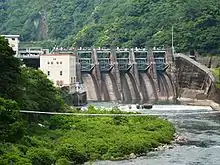
Hydroelectric plants convert the energy of moving water into electricity. On average, hydroelectricity is one of the energy sources that emits the lowest levels of greenhouse gas emissions per unit of energy produced, however levels of emissions vary enormously between projects.[56]
In conventional hydropower, a reservoir is created behind a dam. In most cases, the biological matter that becomes submerged in the flooding of the reservoir decomposes, becoming a source of carbon dioxide and methane.[57] These greenhouse gas emissions are particularly large in tropical regions.[58] In turn, deforestation and climate change can reduce energy generation from hydroelectric dams.[59] Depending on location, the implementation of large-scale dams can displace residents and cause significant local environmental damage.[59]
In general, run-of-the-river hydroelectricity facilities have less environmental impact than reservoir-based facilities, but their ability to generate power depends on river flow, which can vary with daily and seasonal weather conditions.[60]
In 2019, hydropower supplied 16% of the world's electricity, down from a high of nearly 20% in the mid-to late 20th century.[61][62] It produced 60% of electricity in Canada and nearly 80% in Brazil.[61] Reservoir-based hydropower plants provide a highly flexible, dispatchable electricity supply. They can be combined with wind and solar power to provide peak load and to compensate when wind and sun are less available.[59]
Geothermal

Geothermal energy is produced by tapping into the thermal energy created and stored within the earth. It arises from the radioactive decay of an isotope of potassium and other elements found in the Earth's crust.[63] Geothermal energy is considered renewable and sustainable because that thermal energy is constantly replenished.[64]
Geothermal energy can be harnessed to for electricity generation and for heating. The use of geothermal energy is concentrated in regions where heat extraction is economical: a combination of heat, flow and high permeability is needed.[65] Worldwide in 2018, geothermal provided 0.6% of heating and cooling final energy demand in buildings.[50]
The greenhouse gas emissions of geothermal electric stations are on average 45 grams of carbon dioxide per kilowatt-hour of electricity, or less than 5 percent of that of conventional coal-fired plants.[66] Geothermal energy can be obtained by drilling into the ground, very similar to oil exploration, and then it is carried by a heat-transfer fluid (e.g. water, brine or steam).[63] Within these liquid-dominated systems, there are possible concerns of subsidence and contamination of ground-water resources. Therefore, protection of ground-water resources is necessary in these systems.[67]
Bioenergy
.jpg.webp)

Biomass is a versatile and common source of renewable energy. It is available in many countries, which makes it attractive for reducing dependence on imported fossil fuels. If the production of biomass is well-managed, carbon emissions can be significantly offset by the absorption of carbon dioxide by the plants during their lifespans. Biomass can either be burned to produce heat and to generate electricity or converted to modern biofuels such as biodiesel and ethanol. Biofuels are often produced from corn or sugar cane. They are used to power transport, often blended with liquid fossil fuels.
Use of farmland for growing biomass can result in less land being available for growing food. Since photosynthesis is inherently inefficient, and crops also require significant amounts of energy to harvest, dry, and transport, the amount of energy produced per unit of land area is very small, in the range of 0.25 W/m2 to 1.2 W/m2.[68] If biomass is harvested from crops, such as tree plantations, the cultivation of these crops can displace natural ecosystems, degrade soils, and consume water resources and synthetic fertilizers.[69][70] In some cases, these impacts can actually result in higher overall carbon emissions compared to using petroleum-based fuels.[70][71]
In the United States, corn-based ethanol has replaced less than 10% of motor gasoline use since 2011, but has consumed around 40% of the annual corn harvest in the country.[70] In Malaysia and Indonesia, the clearing of forests to produce palm oil for biodiesel has led to serious social and environmental effects, as these forests are critical carbon sinks and habitats for endangered species.[72]
More sustainable sources of biomass include crops grown on soil unsuitable for food production, algae and waste. If the biomass source is agricultural or municipal waste, burning it or converting it into biogas also provides a way to dispose of this waste.[69] Cellulosic ethanol has many benefits over traditional corn based-ethanol. It does not take away or directly conflict with the food supply because it is produced from wood, grasses, or non-edible parts of plants.[73] However, as of 2020, there have been few commercial plants of cellulosic ethanol, mostly concentrated in Europe.[74][75]
According to the UK Committee on Climate Change in the long term all uses of biomass must maximise carbon sequestration, for example by using it in conjunction with carbon capture and storage (BECCS) when the biomass is burned,[76] and move "away from using biofuels in surface transport, biomass for heating buildings, or biomass for generating power without CCS".[77] Due to lack of technologically feasible alternatives, aviation biofuel may one of the best uses of biomass, providing that some carbon is captured and stored during manufacture of the fuel.[76]
Marine energy
Marine energy represents the smallest share of the energy market. It encompasses tidal power, which is approaching maturity, and wave power, which is earlier in its development. Two tidal barrage system, in France and in Korea, make up 90% of total production. While single devices pose little risk to the environment, the impacts of multi-array devices are less well known.[78]
Non-renewable energy sources
Nuclear power

Nuclear power plants have been used since the 1950s to produce a zero emission, steady supply of electricity, without creating local air pollution. In 2019, nuclear power plants in over 30 countries generated 10% of global electricity.[79] Nuclear power is a low-carbon energy source, with lifecycle greenhouse gas emissions (including the mining and processing of uranium), similar to the emissions from renewable energy sources.[80] As of 2020 nuclear power provides half of European Union low-carbon electricity and a quarter of the bloc's total generation.[81]
There is considerable controversy over whether nuclear power can be considered sustainable, with debates revolving around the risk of nuclear accidents, the cost and construction time needed to build new plants, the generation of radioactive nuclear waste, and the potential for nuclear energy to contribute to nuclear proliferation. These concerns spurred the anti-nuclear movement. Public support for nuclear energy is often low as a result of safety concerns, however for each unit of energy produced, nuclear energy is far safer than fossil fuel energy and comparable to renewable sources.[82] The uranium ore used to fuel nuclear fission plants is a non-renewable resource, but sufficient quantities exist to provide a supply for hundreds of years.[83]
Thorium is a fissionable material used in thorium-based nuclear power. The thorium fuel cycle claims several potential advantages over a uranium fuel cycle, including greater abundance, superior physical and nuclear properties, better resistance to nuclear weapons proliferation[84][85] and reduced plutonium production.[85] Therefore, it is sometimes referred as sustainable.[86]
A prospective energy source is nuclear fusion (as opposed to nuclear fission used today). It is the reaction that exists in stars, including the Sun. Fusion reactors currently in construction are expected to be inherently safe due to lack of chain reaction and do not produce long-lived nuclear waste.[87] The fuels for nuclear fusion reactors are widely available deuterium, lithium and tritium.[88]
(Fossil) fuel switching
On average for a given unit of energy produced, the greenhouse gas emissions of natural gas are around half the emissions of coal when used to generate electricity, and around two-thirds the emissions of coal when used to produce heat: however reducing methane leaks is imperative.[89] Natural gas also produces significantly less air pollution than coal. Building gas-fired power plants and gas pipelines is therefore promoted as a way to phase out coal and wood burning pollution (and increase energy supply in some African countries with fast growing populations or economies),[18] however this practice is controversial. Opponents argue that developing natural gas infrastructure will create decades of carbon lock-in and stranded assets, and that renewables create far less emissions at comparable costs.[90] The life-cycle greenhouse-gas emissions of natural gas are around 40 times the emissions of wind and nuclear energy.[91] Switching cooking from dirty fuels such as wood or kerosene to LPG has been criticised and biogas or electricity has been suggested as an alternative.[92]
Sustainable energy systems
Electricity generation
As of 2018, about a quarter of all electricity generation came from modern renewable sources (excluding the traditional use of biomass). The growth of renewable energy usage has been significantly faster in this sector than in heating and transport.[93]
Heating and cooling
A large fraction of the world population cannot afford sufficient cooling or live in poorly designed houses. In addition to air conditioning, which requires electrification and additional power demand, passive building design and urban planning will be needed to ensure cooling needs are met in a sustainable way.[94] Similarly, many households in the developing and developed world suffer from fuel poverty and cannot heat their houses enough.[95] Existing heating practices are often polluting. Alternatives to fossil fuel heating include waste heat, solar thermal, geothermal, electrification (heat pumps, or the less efficient electric heater) and biomass.[96][97][98] The costs of all these technologies strongly depend on location, and uptake of the technology sufficient for deep decarbonisation requires stringent policy interventions.[98]
Transport
There are multiple ways to make transport more sustainable. Public transport usually requires less energy per passenger than personal vehicles such as cars. In cities, transport can be made cleaner by stimulating nonmotorised transport such as cycling. Energy efficiency of cars has increased significantly, often due to regulation-driven innovation. Electric vehicles use less energy per kilometre, and as electricity is more easily produced sustainably than fuel, also contribute to making transport more sustainable.[99] Hydrogen vehicles may be an alternative for larger vehicles which have not yet been widely electrified, such as long distance lorries.[100] Many of the techniques needed to lower emissions from shipping and aviations are still in early in their development.[101]
Industry
Of final energy demand, over one third is used by industry. Most of that energy is deployed in thermal processes: generating steam, drying and refrigeration. The share of renewable energy in industry was 14.5% in 2017, which mostly include low-temperature heat supplied by bioenergy and electricity. The more energy intensive part of industry have the lowest penetration, where renewables face limitations to meet heat demand over 200 °C.[102] For some industrial processes, such as steel production, commercialization of technologies that have not yet been built or operated at full scale is needed to elimanate greenhouse gas emissions.[103]
Carbon capture and storage
In theory, the greenhouse gas emissions of fossil fuel and biomass power plants can be significantly reduced through carbon capture and storage (CCS), although this process is expensive. To compare the costs of wind and solar power with that from natural gas with CCS it is necessary to estimate not just the levelized cost of energy but the whole system cost.[55] These will depend considerably on the location due to differences in carbon prices, grid enhancements needed for flexibility, and availability of suitable geology for carbon dioxide storage.[55][104]
When CCS is used to capture emissions from burning biomass in a process known as bioenergy with carbon capture and sequestration (BECCS), the overall process can result in net carbon dioxide removal from the atmosphere. The BECCS process can also result in net positive emissions depending on how the biomass material is grown, harvested, and transported.[105] As of 2014, the lowest-cost mitigation pathways for meeting the 2 °C target typically describe massive deployment of BECCS.[105] However, using BECCS at the scale described in these pathways would require more resources than are currently available worldwide. For example, to capture 10 billion tons of CO2 per year (GtCO2/y) would require biomass from 40 percent of the world's current cropland.[105]
Managing intermittent energy sources
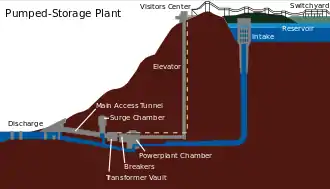
Solar and wind are variable renewable energy sources that supply electricity intermittently depending on the weather and the time of day.[106][107] Most electric grids were constructed for non-intermittent energy sources such as coal-fired power plants.[108] As larger amounts of solar and wind energy are integrated into the grid, it becomes necessary to make changes to the overall system to ensure that the supply of electricity is matched to demand. These changes can include the following:
- Using dispatchable renewables, natural gas plants or nuclear plants to produce flexible power[109]
- Using grid energy storage to store excess solar and wind energy and release it as needed[110]
- Linking different variable renewable resources, and linking different geographical regions through long-distance transmission lines[111]
- Reducing demand for electricity at certain times through energy demand management and use of smart grids.
- Energy market, or more specifically electricity market, changes so that power supply flexibility is better paid[112][113]
As of 2019, the cost and logistics of energy storage for large population centers is a significant challenge, although the cost of battery systems has plunged dramatically.[114] For instance, a 2019 study found that for solar and wind energy to replace all fossil fuel generation for a week of extreme cold in the eastern and midwest United States, energy storage capacity would have to increase from the 11 GW in place at that time to between 230 GW and 280 GW, depending on how much nuclear power is retired.[114]
Energy storage
Energy storage helps overcome barriers for intermittent renewable energy, and is therefore an important aspect of a sustainable energy system.[115] The most commonly used storage method is pumped-storage hydroelectricity, which requires locations with large differences in height and access to water.[115] Battery storage power stations and home energy storage are being deployed widely.[116] Some lithium-ion batteries contain cobalt, now largely mined in Congo some unsustainably. Responsible sourcing of cobalt[117] and more diverse geographical sourcing may ensure a more stable supply-chain; lithium iron phosphate batteries are becoming more popular[118] and flow batteries are flexible.[119] Environmental impacts can be reduced by downcycling and recycling.[120] Other storage technologies such as power-to-gas have been used in limited situations.[121] Current battery technology is able to store quantities of electricity that can power a community for days; research is ongoing into technology that have the capacity to last through multiple weeks of low wind and solar electricity generation.
As of 2018, thermal energy storage is typically not as convenient as burning fossil fuels. High upfront costs form a barrier for implementation. Seasonal thermal energy storage is common in high latitudes providing heat.[122]
Electrification
Electrification is a key part of using energy sustainably, as many mainstream sustainable energy technologies are electrically powered, in contrast to the technologies they replace.[123] Specifically, massive electrification in the heat and transport sector may be needed to make these sectors sustainable, with heat pumps and electric vehicles playing an important role.[124]
Hydrogen

Hydrogen is an alternative to fossil fuels that is zero-emission at the point of combustion. The overall lifecycle emissions of hydrogen depend on how it is produced. Very little of the world's current supply of hydrogen is created from sustainable sources. Nearly all of it is produced from fossil fuels, which results in high greenhouse gas emissions. With carbon capture and storage technologies, 90% of the carbon dioxide emitted during the production of hydrogen could be removed.[125] Some academics say that CCS is needed in the short term because not enough electrolysis will be available in time.[126]
Hydrogen fuel can be produced through electrolysis, by using electricity to split water molecules into hydrogen and oxygen, and if the electricity is generated sustainably, the resultant fuel will also be sustainable. This process is currently more expensive than creating hydrogen from fossil fuels, and the efficiency of energy conversion is inherently low.[127] Hydrogen can be produced when there is a surplus of intermittent renewable electricity, then stored and used to generate heat or to re-generate electricity. Further conversion to ammonia allows the energy to be more easily stored at room temperature in liquid form.[128]
Hydrogen fuel can produce the intense heat required for industrial production of steel, cement, glass, and chemicals.[126] Steelmaking is considered to be the use of hydrogen which would be most effective in limiting GHG emissions in the short-term.[126]
Twenty per cent hydrogen can be mixed into a natural gas grid without changing pipelines or appliances,[129] but as hydrogen is less energy-dense this would only save 7% of emissions.[130] As of 2020 trials are underway on how to convert a natural gas grid to 100% hydrogen, in order to reduce or eliminate emissions from residential and industrial natural gas heating.[125] Hydrogen fuel cells can be used to power heavy road vehicles.[131] As it has a low energy to volume content, it is easier to use in hydrogen-powered ships[132] than in cars. Use in airplanes is being researched, but despite emitting no carbon dioxide such flights would still impact the climate.[133]
Government energy policies
| Part of a series about |
| Sustainable energy |
|---|
 |
| Overview |
| Energy conservation |
| Renewable energy |
| Sustainable transport |
|
According to the IPCC, both explicit carbon pricing and complementary energy-specific policies are necessary mechanisms to limit global warming to 1.5 °C. Some studies estimate that combining a carbon tax with energy-specific policies would be more cost-effective than a carbon tax alone.[134]
Energy-specific programs and regulations have historically been the mainstay of efforts to reduce fossil fuel emissions. Successful cases include the building of nuclear reactors in France in the 1970s and 1980s, and fuel efficiency standards in the United States which conserved billions of barrels of oil.[135] Other examples of energy-specific policies include energy-efficiency requirements in building codes, banning new coal-fired electricity plants, performance standards for electrical appliances, and support for electric vehicle use.[136][134] Fossil fuel subsidies remain a key barrier to a transition to a clean energy system.[137]
Carbon taxes are an effective way to encourage movement towards a low-carbon economy, while providing a source of revenue that can be used to lower other taxes[138] or to help lower-income households afford higher energy costs.[139] Carbon taxes have encountered strong political pushback in some jurisdictions, whereas energy-specific policies tend to be politically safer.[135] According to the OECD climate change cannot be curbed without carbon taxes on energy, but 70% of energy-related CO
2 emissions were not taxed at all in 2018.[140]
References
- Friedlingstein et al. 2019.
- Kutscher, Charles F. (2019). Principles of sustainable energy systems. Milford, Jana B., Kreith, Frank (Third ed.). Boca Raton, FL: CRC Press. Chapter 1. ISBN 978-0-429-48558-9. OCLC 1049150051.
- "What are the safest and cleanest sources of energy?". Our World in Data. Retrieved 4 January 2021.
- "Wind & Solar Share in Electricity Production Data | Enerdata". Power Technology.
- The Open University. "An introduction to sustainable energy". OpenLearn. Retrieved 30 December 2020.
- Golus̆in, Mirjana (2013). Sustainable energy management. Popov, Stevan,, Dodić, Sinis̆a. Waltham, MA: Academic Press. p. 8. ISBN 978-0-12-391427-9. OCLC 826441532.
- Hammond, Geoffrey P.; Jones, Craig I. (2011). "Sustainability criteria for energy resources and technologies". In Galarraga, Ibon; González-Eguino, Mikel; Markandya, Anil (eds.). Handbook of sustainable energy. Cheltenham, UK: Edward Elgar. pp. 21–47. ISBN 978-1-84980-115-7. OCLC 712777335.
- United Nations Economic Commission for Europe (2020). Pathways to Sustainable Energy (PDF). Geneva: UNECE. pp. 4–5. ISBN 978-92-1-117228-7.CS1 maint: uses authors parameter (link)
- Evans, Robert L. (2007). Fueling our future : an introduction to sustainable energy. Cambridge: Cambridge University Press. pp. 3. ISBN 9780521865630. OCLC 144595567.
- "The Global Energy Challenge". World Bank Blogs. Retrieved 27 September 2019.
- Hannah Ritchie (2019). "Access to Energy". OurWorldInData.org. Retrieved 5 July 2020.
- United Nations 2020, p. 38.
- "Access to clean cooking – SDG7: Data and Projections – Analysis". IEA. Retrieved 28 December 2019.
- "Household air pollution and health: fact sheet". WHO. 8 May 2018. Retrieved 21 November 2020.
- Rao, Narasimha D; Pachauri, Shonali (2017). "Energy access and living standards: some observations on recent trends". Environmental Research Letters. 12 (2): 025011. Bibcode:2017ERL....12b5011R. doi:10.1088/1748-9326/aa5b0d. ISSN 1748-9326.
- Tester 2012, p. 504.
- "Goal 7—Ensure Access to Affordable, Reliable, Sustainable and Modern Energy for All". UN Chronicle. 8 April 2015. Retrieved 27 September 2019.
- "Africa Energy Outlook 2019 – Analysis". IEA. Retrieved 28 August 2020.
- "Global Historical Emissions". Climate Watch. Retrieved 28 September 2019.
- World Resources Institute (June 2015). "CAIT Country Greenhouse Gas Emissions: Sources and Methods" (PDF). Retrieved 28 September 2019.
- "Fossil fuel energy consumption (% of total)". World Bank Open Data (in Indonesian). Retrieved 27 September 2019.
- Loftus, Peter J.; Cohen, Armond M.; Long, Jane C. S.; Jenkins, Jesse D. (2015). "A critical review of global decarbonization scenarios: what do they tell us about feasibility?" (PDF). Wiley Interdisciplinary Reviews: Climate Change. 6: 93–112. doi:10.1002/wcc.324.
- SR15 Summary for policymakers.
- IPCC SR15 2018, C.2.4.2.2.
- IPCC SR15 2018, C.2.4.2.1, Table 2.6 low-OS.
- IPCC SR15 2018, 2.4.2.1, Table 2.6 low-OS.
- IPCC SR15 2018, p. 111.
- IPCC SR15 2018, 2.4.2.1.
- IPCC SR15 2018, 2.4.2.2.
- IPCC SR15 2018, 2.4.3.
- Newburger, Emma (13 March 2020). "Coronavirus could weaken climate change action and hit clean energy investment, researchers warn". CNBC. Retrieved 16 March 2020.
- "Text-Only NPR.org : Climate Change Push Fuels Split on Coronavirus Stimulus". NPR.
- "Put clean energy at the heart of stimulus plans to counter the coronavirus crisis—Analysis". IEA.
- Kuzemko, Caroline; Bradshaw, Michael; et al. (1 October 2020). "Covid-19 and the politics of sustainable energy transitions". Energy Research & Social Science. 68: 101685. doi:10.1016/j.erss.2020.101685. ISSN 2214-6296. PMC 7330551. PMID 32839704.
- Market Report Series: Energy Efficiency 2018 – Analysis (Report). International Energy Agency. Retrieved 21 September 2020.
- Energy Efficiency 2019 – Analysis (Report). International Energy Agency. Retrieved 21 September 2020.
- Mundaca, Luis; Ürge-Vorsatz, Diana; Wilson, Charlie (1 February 2019). "Demand-side approaches for limiting global warming to 1.5 °C". Energy Efficiency. 12 (2): 343–362. doi:10.1007/s12053-018-9722-9. ISSN 1570-6478. S2CID 52251308.
- Huesemann, Michael H., and Joyce A. Huesemann (2011). Technofix: Why Technology Won’t Save Us or the Environment, Chapter 5, "In Search of Solutions: Efficiency Improvements", New Society Publishers, ISBN 978-0-86571-704-6.
- International Energy Agency 2020.
- Cabezas, Heriberto; Huang, Yinlun (1 October 2015). "Issues on water, manufacturing, and energy sustainability". Clean Technologies and Environmental Policy. 17 (7): 1727–1728. doi:10.1007/s10098-015-1031-9. ISSN 1618-9558. S2CID 94335915.
- American Council for an Energy-Efficient Economy (2007). The Twin Pillars of Sustainable Energy: Synergies between Energy Efficiency and Renewable Energy Technology and Policy Report E074.
- International Energy Agency (2007). Renewables in global energy supply: An IEA facts sheet, OECD, 34 pages. Archived 12 October 2009 at the Wayback Machine
- Kutscher, Milford & Kreith 2018, p. 36.
- "How Long Do Solar Panels Last and Replacement Guide". Those Solar Guys. Retrieved 31 December 2019.
- "Waste take-back, treatment & legal compliance | PV CYCLE Association". pvcycle.org. Retrieved 31 December 2019.
- Belton, Padraig (1 May 2020). "A breakthrough approaches for solar power". BBC News. Retrieved 30 September 2020.
- "Levelized Cost of Energy and Levelized Cost of Storage 2019". Lazard.com. Retrieved 30 September 2020.
- Kutscher, Milford & Kreith 2018, pp. 35–36.
- REN21 2020, p. 124.
- REN21 2020, p. 38.
- "Global Wind Report Annual Market Update". Gwec.net. Retrieved 21 August 2013.
- Nathan F. Jones, Liba Pejchar, Joseph M. Kiesecker. "The Energy Footprint: How Oil, Natural Gas, and Wind Energy Affect Land for Biodiversity and the Flow of Ecosystem Services". BioScience, Volume 65, Issue 3, March 2015. pp.290–301
- Szarka, Joseph. Wind Power in Europe: Politics, Business and Society. Springer, 2007. p.176
- "Critical question: How to recycle 12 000 wind turbines? • Recycling International". Recycling International. 12 July 2019. Retrieved 31 December 2019.
- Evans, Simon (27 August 2020). "Wind and solar are 30-50% cheaper than thought, admits UK government". Carbon Brief. Retrieved 30 September 2020.
- Schlömer S., T. Bruckner, L. Fulton, E. Hertwich, A. McKinnon, D. Perczyk, J. Roy, R. Schaeffer, R. Sims, P. Smith, and R. Wiser, 2014: Annex III: Technology-specific cost and performance parameters. In: Climate Change 2014: Mitigation of Climate Change. Contribution of Working Group III to the Fifth Assessment Report of the Intergovernmental Panel on Climate Change [Edenhofer, O., R. Pichs-Madruga, Y. Sokona, E. Farahani, S. Kadner, K. Seyboth, A. Adler, I. Baum, S. Brunner, P. Eickemeier, B. Kriemann, J. Savolainen, S. Schlömer, C. von Stechow, T. Zwickel and J.C. Minx (eds.)]. Cambridge University Press, Cambridge, United Kingdom and New York, NY, USA, p. 1335
- Scherer, Laura; Pfister, Stephan (14 September 2016). "Hydropower's Biogenic Carbon Footprint". PLOS ONE. 11 (9): e0161947. Bibcode:2016PLoSO..1161947S. doi:10.1371/journal.pone.0161947. ISSN 1932-6203. PMC 5023102. PMID 27626943.
- Almeida, Rafael M.; Shi, Qinru; Gomes-Selman, Jonathan M.; Wu, Xiaojian; Xue, Yexiang; et al. (2019). "Reducing greenhouse gas emissions of Amazon hydropower with strategic dam planning". Nature Communications. 10 (1): 4281. Bibcode:2019NatCo..10.4281A. doi:10.1038/s41467-019-12179-5. ISSN 2041-1723. PMC 6753097. PMID 31537792.
- Moran, Emilio F.; Lopez, Maria Claudia; Moore, Nathan; Müller, Norbert; Hyndman, David W. (2018). "Sustainable hydropower in the 21st century". Proceedings of the National Academy of Sciences. 115 (47): 11891–11898. doi:10.1073/pnas.1809426115. ISSN 0027-8424. PMC 6255148. PMID 30397145.
- Kumar, A., T. Schei, A. Ahenkorah, R. Caceres Rodriguez, J.-M. Devernay, M. Freitas, D. Hall, Å. Killingtveit, Z. Liu, 2011: Hydropower. In IPCC Special Report on Renewable Energy Sources and Climate Change Mitigation [O. Edenhofer, R. Pichs-Madruga, Y. Sokona, K. Seyboth, P. Matschoss, S. Kadner, T. Zwickel, P. Eickemeier, G. Hansen, S. Schlömer, C. von Stechow (eds)], Cambridge University Press, Cambridge, United Kingdom and New York, NY, USA, p. 451
- Smil 2017b, p. 286.
- REN21 2020, p. 48.
- László, Erika (1981). "Geothermal Energy: An Old Ally". Ambio. 10 (5): 248–249. JSTOR 4312703.
- Rybach, Ladislaus (September 2007), "Geothermal Sustainability" (PDF), Geo-Heat Centre Quarterly Bulletin, Klamath Falls, Oregon: Oregon Institute of Technology, 28 (3), pp. 2–7, ISSN 0276-1084, retrieved 9 May 2009
- REN21 2020, p. 97.
- Moomaw, W., P. Burgherr, G. Heath, M. Lenzen, J. Nyboer, A. Verbruggen, 2011: Annex II: Methodology. In IPCC: Special Report on Renewable Energy Sources and Climate Change Mitigation (ref. page 10)
- Dorfman, Myron H. (July 1976). "Water Required to Develop Geothermal Energy". Journal (American Water Works Association). 68 (7): 370–375. doi:10.1002/j.1551-8833.1976.tb02435.x. JSTOR 41268497.
- Smil 2017a, p. 161.
- Tester 2012, p. 512.
- Smil 2017a, p. 162.
- Edenhofer 2014, p. 616.
- Lustgarten, Abrahm (20 November 2018). "Palm Oil Was Supposed to Help Save the Planet. Instead It Unleashed a Catastrophe". The New York Times. ISSN 0362-4331. Retrieved 15 May 2019.
- M.R. Schmer; K.P. Vogel; R.B. Mitchell; R.K. Perrin (2008). "Net energy of cellulosic ethanol from switchgrass". Proceedings of the National Academy of Sciences of the United States of America. 105 (2): 464–469. Bibcode:2008PNAS..105..464S. doi:10.1073/pnas.0704767105. PMC 2206559. PMID 18180449.
- "Clariant bets big on cellulosic ethanol". Chemical & Engineering News. Retrieved 6 June 2019.
- REN21 2020, p. 89.
- Biomass in a low-carbon economy (Report). UK Committee on Climate Change. November 2018. p. 18.
Our analysis points to end-uses that maximise sequestration (storage of carbon) as being optimal in 2050. These include wood in construction and the production of hydrogen, electricity, industrial products and potentially also aviation biofuels, all with carbon capture and storage. Many current uses of biomass are not in line with longterm best-use and these will need to change.
- Biomass in a low-carbon economy (Report). UK Committee on Climate Change. November 2018. p. 12.
- REN21 2020, p. 103-106.
- "Nuclear Power Today | Nuclear Energy - World Nuclear Association". www.world-nuclear.org. Retrieved 1 November 2020.
- "IPCC Working Group III – Mitigation of Climate Change, Annex III: Technology - specific cost and performance parameters" (PDF). IPCC. 2014. p. 7. Retrieved 14 December 2018.
- "Electricity Generation". FORATOM. Retrieved 27 May 2020.
- Ritchie, Hannah (10 February 2020). "What are the safest and cleanest sources of energy?". Our World in Data. Archived from the original on 29 November 2020. Retrieved 2 December 2020.
- "Ch 24 Page 162: Sustainable Energy - without the hot air | David MacKay". withouthotair.com. Retrieved 26 June 2020.
- Kang, J.; Von Hippel, F. N. (2001). "U‐232 and the proliferation‐resistance of U‐233 in spent fuel". Science & Global Security. 9 (1): 1. Bibcode:2001S&GS....9....1K. doi:10.1080/08929880108426485. S2CID 8033110. "Archived copy" (PDF). Archived from the original (PDF) on 3 December 2014. Retrieved 2 March 2015.CS1 maint: archived copy as title (link)
- Robert Hargraves; Ralph Moir (January 2011). "Liquid Fuel Nuclear Reactors". American Physical Society Forum on Physics & Society. Retrieved 31 May 2012.
- "Th-ING: A Sustainable Energy Source". Los Alamos National Laboratory. 2015.
- Fernandez, Elizabeth. "The US Comes One Step Closer To Producing Commercial Fusion Power". Forbes. Retrieved 30 May 2020.
- MacKay, David. "Ch 24 Page 172: Sustainable Energy - without the hot air". withouthotair.com. Retrieved 26 June 2020.
- "The Role of Gas: Key Findings". International Energy Agency. 4 October 2019. Retrieved 4 October 2019.
- "As Coal Fades in the U.S., Natural Gas Becomes the Climate Battleground". The New York Times. 26 June 2019. Retrieved 4 October 2019.
- "IPCC Working Group III – Mitigation of Climate Change, Annex III: Technology - specific cost and performance parameters - Table A.III.2 (Emissions of selected electricity supply technologies (gCO 2eq/kWh))" (PDF). IPCC. 2014. p. 1335. Retrieved 14 December 2018.
- Foundation, Thomson Reuters. "Dirty secret: Half of world lacks clean cooking, at a huge cost". news.trust.org. Retrieved 11 October 2020.
- REN21 2020, p. 15.
- Mastrucci, Alessio; Byers, Edward; Pachauri, Shonali; Rao, Narasimha D. (2019). "Improving the SDG energy poverty targets: Residential cooling needs in the Global South". Energy and Buildings. 186: 405–415. doi:10.1016/j.enbuild.2019.01.015. ISSN 0378-7788.
- Bouzarovski, Stefan; Petrova, Saska (2015). "A global perspective on domestic energy deprivation: Overcoming the energy poverty–fuel poverty binary". Energy Research & Social Science. 10: 31–40. doi:10.1016/j.erss.2015.06.007. ISSN 2214-6296.
- Mortensen, Anders Winther; Mathiesen, Brian Vad; Hansen, Anders Bavnhøj; Pedersen, Sigurd Lauge; Grandal, Rune Duban; Wenzel, Henrik (1 October 2020). "The role of electrification and hydrogen in breaking the biomass bottleneck of the renewable energy system – A study on the Danish energy system". Applied Energy. 275: 115331. doi:10.1016/j.apenergy.2020.115331. ISSN 0306-2619.
- Van de Vyver, Ighor; Harvey-Scholes, Calum; Hoggett, Richard (January 2020). "A common approach for sustainable heating strategies for partner cities" (PDF).
- Knobloch, Florian; Pollitt, Hector; Chewpreecha, Unnada; Daioglou, Vassilis; Mercure, Jean-Francois (2019). "Simulating the deep decarbonisation of residential heating for limiting global warming to 1.5 °C". Energy Efficiency. 12 (2): 521–550. doi:10.1007/s12053-018-9710-0. ISSN 1570-6478. S2CID 52830709.
- Bamwesigye, Dastan; Hlavackova, Petra (2019). "Analysis of Sustainable Transport for Smart Cities". Sustainability. 11 (7): 2140. doi:10.3390/su11072140.
- Miller, Joe (9 September 2020). "Hydrogen takes a back seat to electric for passenger vehicles". www.ft.com. Retrieved 20 September 2020.
- International Energy Agency 2020, p. 139.
- REN21 2020, p. 40.
- International Energy Agency 2020, p. 135.
- "CCUS in Power – Analysis". IEA. Retrieved 30 September 2020.
- National Academies of Sciences, Engineering (2019). Negative Emissions Technologies and Reliable Sequestration: A Research Agenda. Washington, D.C.: National Academies of Sciences, Engineering, and Medicine. p. 3. doi:10.17226/25259. ISBN 978-0-309-48452-7. PMID 31120708.
- Jerez, Sonia; Tobin, Isabelle; Turco, Marco; María López-Romero, Jose; Montávez, Juan Pedro; Jiménez-Guerrero, Pedro; Vautard, Robert (2018). "Resilience of the combined wind-plus-solar power production in Europe to climate change: a focus on the supply intermittence". EGUGA: 15424. Bibcode:2018EGUGA..2015424J.
- Lave, M.; Ellis, A. (2016). "Comparison of solar and wind power generation impact on net load across a utility balancing area". 2016 IEEE 43rd Photovoltaic Specialists Conference (PVSC): 1837–1842. doi:10.1109/PVSC.2016.7749939. ISBN 978-1-5090-2724-8. OSTI 1368867. S2CID 44158163.
- "Introduction to System Integration of Renewables – Analysis". IEA. Retrieved 30 May 2020.
- International Energy Agency 2020, p. 109.
- Ortiz, Diego Arguedas. "How hydrogen is transforming these tiny Scottish islands". BBC. Retrieved 28 December 2019.
- REN21 2020, p. 177.
- "World's 'largest, most ambitious' energy flexibility market trials to launch in the UK". Current. Retrieved 4 June 2020.
- "U.S. regulatory innovation to boost power system flexibility and prepare for ramp up of wind and solar – Analysis". IEA. Retrieved 4 June 2020.
- "100% Renewable Energy Needs Lots of Storage. This Polar Vortex Test Showed How Much". InsideClimate News. 20 February 2019. Retrieved 4 June 2019.
- Koohi-Fayegh, S.; Rosen, M.A. (2020). "A review of energy storage types, applications and recent developments". Journal of Energy Storage. 27: 101047. doi:10.1016/j.est.2019.101047. ISSN 2352-152X.
- Katz, Cheryl. "The batteries that could make fossil fuels obsolete". BBC. Retrieved 10 January 2021.
- Baumann-Pauly, Professor Dorothée. "Cobalt can be sourced responsibly, and it's time to act". SWI swissinfo.ch. Retrieved 10 January 2021.
- "Energy storage market is evolving, with shifts in battery chemistry and system design". ITP Media Group. 12 December 2020.
- POWER (2 March 2020). "Flow Batteries: Energy Storage Option for a Variety of Uses". POWER Magazine. Retrieved 10 January 2021.
- Babbitt, Callie W. (2020). "Sustainability perspectives on lithium-ion batteries". Clean Technologies and Environmental Policy. 22 (6): 1213–1214. doi:10.1007/s10098-020-01890-3. ISSN 1618-9558. S2CID 220351269.
- "To batteries and beyond: With seasonal storage potential, hydrogen offers 'a different ballgame entirely'". Utility Dive. Retrieved 10 January 2021.
- Alva, Guruprasad; Lin, Yaxue; Fang, Guiyin (2018). "An overview of thermal energy storage systems". Energy. 144: 341–378. doi:10.1016/j.energy.2017.12.037. ISSN 0360-5442.
- Roberts, David (6 August 2020). "How to drive fossil fuels out of the US economy, quickly". Vox. Retrieved 21 August 2020.
- Bogdanov, Dmitrii; Farfan, Javier; Sadovskaia, Kristina; Aghahosseini, Arman; Child, Michael; Gulagi, Ashish; Oyewo, Ayobami Solomon; de Souza Noel Simas Barbosa, Larissa; Breyer, Christian (6 March 2019). "Radical transformation pathway towards sustainable electricity via evolutionary steps". Nature Communications. 10 (1): 1077. Bibcode:2019NatCo..10.1077B. doi:10.1038/s41467-019-08855-1. ISSN 2041-1723. PMC 6403340. PMID 30842423.
- "Transitioning to hydrogen: Assessing the engineering risks and uncertainties". theiet.org. Retrieved 11 April 2020.
- "Hydrogen's Decarbonization Impact for Industry" (PDF). Rocky Mountain Institute. January 2020.
- Evans, Simon; Gabbatiss, Josh (30 November 2020). "In-depth Q&A: Does the world need hydrogen to solve climate change?". Carbon Brief. Retrieved 1 December 2020.
- Palys, Matthew J.; Daoutidis, Prodromos (2020). "Using hydrogen and ammonia for renewable energy storage: A geographically comprehensive techno-economic study". Computers & Chemical Engineering. 136: 106785. doi:10.1016/j.compchemeng.2020.106785. ISSN 0098-1354.
- Harrabin, Roger (2 January 2020). "Climate change hope for hydrogen fuel". BBC News. Retrieved 22 September 2020.
- Staffell, Iain; et al. (2019). Electric Insights Quarterly (PDF). drax. p. 9.
- Lathia, Rutvik Vasudev; Dobariya, Kevin S.; Patel, Ankit (January 2017). "Hydrogen Fuel Cells for Road Vehicles". Journal of Cleaner Production. 141: 462. doi:10.1016/j.jclepro.2016.09.150.
- "Hydrogen Fuel Cell trucks can decarbonise heavy transport". Energy Post. 17 October 2019. Retrieved 1 January 2020.
- Welle (www.dw.com), Deutsche. "At Airbus a hydrogen-powered aircraft takes shape | DW | 25.09.2020". DW.COM. Retrieved 28 October 2020.
- IPCC SR15 2018, 2.5.2.1.
- Plumer, Brad (8 October 2018). "New U.N. Climate Report Says Put a High Price on Carbon". The New York Times. ISSN 0362-4331. Retrieved 4 October 2019.
- Lathia, Rutvik Vasudev; Dadhaniya, Sujal (February 2017). "Policy formation for Renewable Energy sources". Journal of Cleaner Production. 144: 334–336. doi:10.1016/j.jclepro.2017.01.023.
- "Fossil Fuel to Clean Energy Subsidy Swaps: How to pay for an energy revolution" (PDF). International Institute for Sustainable Development. June 2019.
- "Revenue-Neutral Carbon Tax | Canada | UNFCCC". unfccc.int. Retrieved 28 October 2019.
- Carr, Mathew (10 October 2018). "How High Does Carbon Need to Be? Somewhere From $20-$27,000". Retrieved 4 October 2019.
- "Taxes on polluting fuels are too low to encourage a shift to low-carbon alternatives - OECD". oecd.org. Retrieved 30 May 2020.
Bibliography
- Edenhofer, Ottmar (2014). Climate Change 2014: Mitigation of Climate Change : Working Group III contribution to the Fifth Assessment Report of the Intergovernmental Panel on Climate Change. New York, NY: Cambridge University Press. ISBN 978-1-107-05821-7. OCLC 892580682.
- Cozzi, Laura; Gould, Tim (2020). World Energy Outlook 2020. International Energy Agency. ISBN 978-92-64-44923-7.
- IPCC (2018). Masson-Delmotte, V.; Zhai, P.; Pörtner, H.-O.; Roberts, D.; et al. (eds.). Global Warming of 1.5°C. An IPCC Special Report on the impacts of global warming of 1.5°C above pre-industrial levels and related global greenhouse gas emission pathways, in the context of strengthening the global response to the threat of climate change, sustainable development, and efforts to eradicate poverty (PDF). Intergovernmental Panel on Climate Change.
- Summary for policymakers, 32 pp.
- Kutscher, C.F.; Milford, J.B.; Kreith, F. (2018). Principles of Sustainable Energy Systems. Mechanical and Aerospace Engineering Series (Third ed.). CRC Press. ISBN 978-0-429-93916-7. Retrieved 10 February 2019.
- Renewables 2020: Global Status Report (PDF). Paris: REN21. 2020. ISBN 978-3-948393-00-7.
- Smil, Vaclav (2017a). Energy Transitions: Global and National Perspectives. Santa Barbara, California: Praeger, an imprint of ABC-CLIO, LLC. ISBN 978-1-4408-5324-1. OCLC 955778608.
- Smil, Vaclav (2017b). Energy and Civilization : A History. Cambridge, Massachusetts: The MIT Press. ISBN 978-0-262-03577-4. OCLC 959698256.
- Tester, Jefferson (2012). Sustainable Energy : Choosing Among Options. Cambridge, MA: MIT Press. ISBN 978-0-262-01747-3. OCLC 892554374.
- Jensen, Lois, ed. (2020). The Sustainable Development Goals Report 2020 (PDF). New York: United Nations. ISBN 978-92-1-101425-9.
